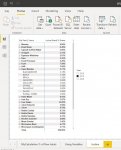chriscorpion786
Board Regular
- Joined
- Apr 3, 2011
- Messages
- 112
- Office Version
- 365
- Platform
- Windows
Hi All,
Im trying to find a DAX solution to evaluate percentages for subtotals. I have 2 columns, SubFamily and within it I have Brand names, so I need to find the percentage of each
Brand within that Sub family and the sub family should also show percentage of the grand total.
It will be clear in the attached image I have uploaded. Iron Steam is a sub family name so the 12.2% share shows its weight in the category of sub family name, at same time,within this category there are many brands for e.g Philips shows 34.95% share withing the Brands. All these are correct and I got a solution from the internet, but I didnt understand it.
Is there a better way of writing it in DAX which makes more sense to do this.
Please help.
Im trying to find a DAX solution to evaluate percentages for subtotals. I have 2 columns, SubFamily and within it I have Brand names, so I need to find the percentage of each
Brand within that Sub family and the sub family should also show percentage of the grand total.
It will be clear in the attached image I have uploaded. Iron Steam is a sub family name so the 12.2% share shows its weight in the category of sub family name, at same time,within this category there are many brands for e.g Philips shows 34.95% share withing the Brands. All these are correct and I got a solution from the internet, but I didnt understand it.
Is there a better way of writing it in DAX which makes more sense to do this.
Please help.










